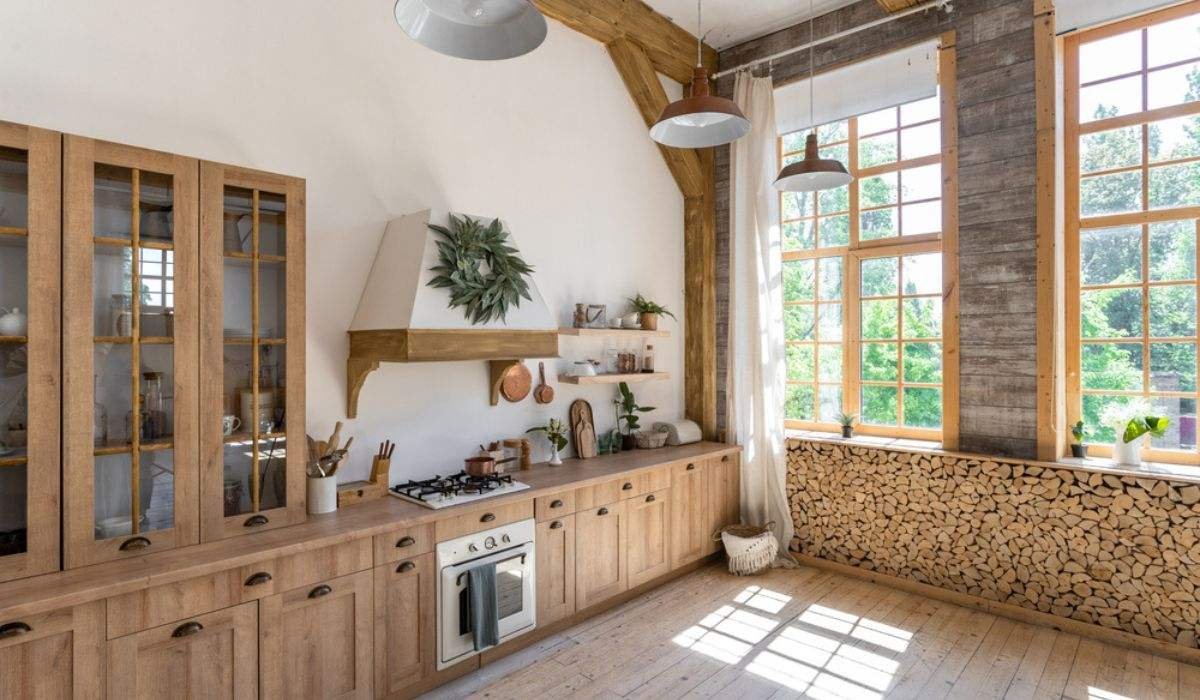The kitchen, often referred to as the “heart of the home,” is a place where culinary creations come to life and family gatherings take centre stage. The importance of proper ventilation in this bustling hub cannot be overstated. Integrating windows into kitchen design not only provides natural light but also plays an important role in maintaining a well-ventilated and inviting environment. In this exploration, we will dissect the art of integrating kitchen design with windows, delving into practical tips, creative approaches and answering frequently asked questions in order to empower homeowners in their pursuit of a kitchen that breathes and inspires.
Strategic window placement
Strategic window placement is the first step in optimising kitchen design for ventilation. Consider your home’s natural airflow and position windows to catch prevailing breezes. Placing windows near cooking areas, sinks and food preparation zones helps to remove cooking odours, steam and heat more efficiently. Furthermore, aligning windows with the cardinal directions can maximise natural light entry while minimising direct sunlight exposure, resulting in a more comfortable and well-lit kitchen space.
Importance of cross ventilation
Cross-ventilation, or the art of directing air flow through opposite openings, is a tried-and-true method for revitalising indoor spaces. Take advantage of cross-ventilation by strategically placing windows on opposite sides of the room when designing a kitchen with windows. This not only helps to remove cooking fumes, but it also improves overall air circulation, creating a breezy and pleasant atmosphere.
Choosing right window dimension
The size of the windows is critical in determining the effectiveness of kitchen ventilation. Choose large windows to allow plenty of fresh air and sunlight into the space. Large windows also provide a visual connection to the outdoors, making the kitchen feel larger and more inviting. Consider incorporating features such as sliding or casement windows that can be opened to varying degrees, allowing you to control the amount of ventilation.
Impact of windows styles
The style of windows chosen can have an impact on both the aesthetics and functionality of the kitchen. Casement windows, which open like doors, provide excellent ventilation control, allowing homeowners to direct airflow as desired. Awning windows, which are hinged at the top and open outward, are another practical option, especially in rainy areas, because they can be left open even during light showers. Furthermore, combining various window styles in the kitchen design can result in a dynamic and visually appealing composition.
Synergy of ventilation hoods
Integrating ventilation hoods and windows improves the effectiveness of both elements in keeping the kitchen fresh and odour-free. Positioning the range hood near a window allows cooking vapours to be expelled directly to the outside. Choose a ventilation hood with adequate power for the size of the cooking area to capture and remove cooking odours efficiently.
Balancing privacy
While natural light and ventilation should be maximised, privacy should also be considered in kitchen design. Investigate window treatment options that strike a balance between transparency and seclusion. Sheer curtains, bamboo blinds, or frosted window films are versatile options for maintaining privacy while allowing in natural light. Choosing treatments that are simple to clean and maintain ensures a sanitary kitchen environment.
Greenery in the kitchen
Greenery near the kitchen windows not only adds a touch of nature but also helps to improve indoor air quality. Potted herbs, small flowering plants or succulents can be placed on windowsills or dedicated shelving. Certain plants, such as aloe vera and spider plants, have air-purifying properties that improve the overall freshness of the kitchen.
Creativity in designing windows
Incorporate unique window features to unleash your creativity in kitchen design. Bay or garden windows, for example, not only let in plenty of light but also create cosy nooks for extra seating or display areas. A window backsplash that extends the window area all the way down to the countertop can add an innovative design element while also providing increased ventilation and a clear view of the outdoors.
Optimal blend of features
The integration of windows emerges as a symphony of functionality, aesthetics and health in the orchestration of a well-designed kitchen. Aside from being natural light portals, well-placed and thoughtfully selected windows transform the kitchen into a dynamic space where fresh air and outdoor vistas become essential ingredients. The kitchen’s ventilation system becomes an architectural dance, effortlessly choreographed to enhance the culinary experience, from the strategic placement of windows to the creative fusion of different styles. As homeowners embark on the journey of kitchen design with windows, the combination of practicality and creativity becomes the recipe for a space that not only breathes but also inspires, making every cooking endeavour a delightful and invigorating experience.
See also: Kitchen shutters
FAQs
Can I install windows in a small kitchen for proper ventilation?
Yes, even in a small kitchen, strategic window placement and choosing appropriately sized windows can enhance ventilation. Consider compact window styles like awning or casement windows that provide effective airflow without compromising valuable wall space.
What is the ideal height for kitchen windows?
The ideal height for kitchen windows depends on the layout and preferences. Placing windows above countertops allows for natural light without sacrificing valuable storage space. Eye-level windows near cooking and prep areas can offer both light and ventilation without hindering the placement of cabinets.
Are there energy-efficient window options for kitchens?
Yes, energy-efficient window options are available for kitchens. Look for windows with Low-E (low-emissivity) coatings and double or triple glazing to enhance insulation. Additionally, consider windows with ENERGY STAR certification for optimal energy efficiency.
How can I enhance kitchen ventilation without windows?
If windows are limited or not feasible, enhance kitchen ventilation by installing a powerful exhaust fan or range hood. These systems can effectively remove cooking odours, steam and pollutants, ensuring a well-ventilated kitchen environment.
What window treatments are suitable for kitchens with high humidity?
Kitchens with high humidity levels, particularly near sinks and cooking areas, benefit from moisture-resistant window treatments. Consider options like faux wood blinds, vinyl roller shades, or aluminium blinds that are resistant to warping or damage from moisture.
Can I combine different window styles in my kitchen design?
Yes, combining different window styles in kitchen design adds visual interest and functionality. For example, pairing casement windows near the sink with a large picture window overlooking a garden creates a dynamic and versatile arrangement.
Are there specific plants that are suitable for kitchen windowsills?
Various plants thrive on kitchen windowsills, such as basil, mint, thyme, succulents like aloe vera, pothos, and herbs. These plants not only add a fresh scent and are useful for cooking but also thrive in the typical bright, indirect kitchen light, contributing to better indoor air quality. Succulents and pothos require minimal care, while aloe vera serves both as a remedy for minor burns and as an attractive addition with its spiky leaves. These plants enhance the kitchen's aesthetics and bring a touch of nature into the home.
| Got any questions or point of view on our article? We would love to hear from you. Write to our Editor-in-Chief Jhumur Ghosh at jhumur.ghosh1@housing.com |

Upasana Mandhata, currently in her final year of Law, is pursuing a BA LLB Degree at VIT University Chennai. Her interest in content creation dates back to her school and college years when she discovered a writing passion. Drawing from personal experiences, her writing style has been shaped by her journey and encounters. She enjoys experimenting with new recipes, painting, or swimming while clocking out of work time.












